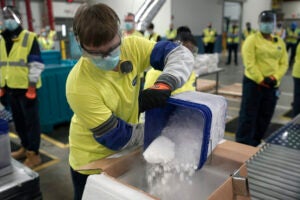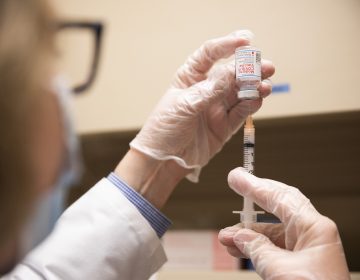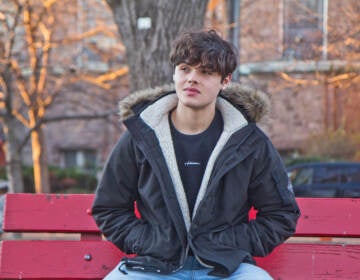Pa. coronavirus update: More doses of vaccine, faster distribution and more federal funding needed
The new COVID-19 relief package has funding for vaccine distribution but the money hasn’t arrived yet.
Listen 1:46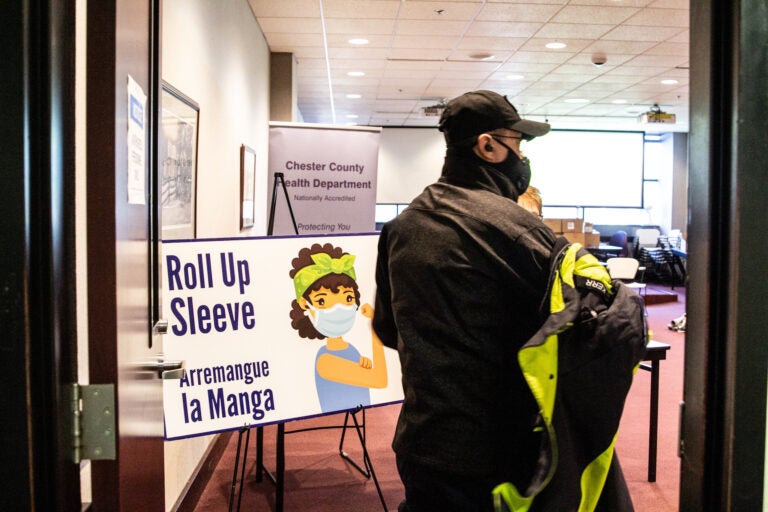
James Kerr, an EMT with Emergency Medical Staffing Solutions, enters the Chester County Public Health Department’s health clinic to receive the Moderna vaccine. (Kimberly Paynter/WHYY)
Ask us about COVID-19: What questions do you have about the current surge?
Updated at 7:08 p.m.
Since Monday, Philadelphia had 805 new cases of COVID-19, leading to a total of 94,127 cases since the start of the pandemic, according to Health Commissioner Thomas Farley. There are another 111 probable cases from quicker antigen tests, which can be done in minutes but are less accurate.
Farley said the city was at about the same place in the pandemic last week as it was a week before: The number of cases has gone down from around 570 a day (December 20 to 26), to around 487 a day (December 27 to January 3). But the percent of tests that come back positive has gone from 8.7% to 9.1%. He added there may be a delay in test results coming back because of the New Year’s holiday.
The number of people in Philadelphia hospitals because of COVID-19 has been generally going down since mid December, and is at 693 as of Tuesday. There have been 36 new deaths due to COVID-19 since yesterday.
Farley said these numbers are high, and related to the high number of COVID-19 cases.
Update on restrictions
Farley also said the restrictions that Philadelphia put in place, such as closing down gyms and museums and indoor dining, has helped. He pointed out that while the restrictions were in effect from Nov. 20 to Jan. 3, the case rates in Philadelphia have fallen by 38%, while case rates across the state rose by 20%. Case rates in the suburban counties of Philadelphia increased as well.
The city lifted some restrictions on Monday, such as reopening gyms and museums and allowing in-person classes at high schools. Farley said people still need to wear masks indoors, and there should not be more than 5 people per thousand square feet of space.
Other restrictions, such as the ban on indoor dining, theaters opening and in-person college classes, will stay in place until January 15. But Farley added he hopes to have an update on when those restrictions might change by the end of this week.
More doses of vaccine, faster distribution, and more federal funding needed
Farley said the city is still vaccinating health care workers and people who live and work in nursing homes — the first priority group to get vaccinated. As of this past Sunday, 28,476 people have been vaccinated, representing 39% of the doses that the city got from the federal government.
There will be more doses coming this week: 9,500 doses of the Moderna vaccine and 9,750 doses of the Pfizer vaccine. Farley said the city will be getting the same amount each week until the end of the month. He said, at that rate, it would take more than a year to vaccinate the 1.6 million people in the whole city so he hopes the city can get additional doses.
He also said that federal funding and more doses would allow the city to vaccinate more people, faster. The new COVID-19 relief package has funding for vaccine distribution but the money hasn’t arrived yet.
This week, health care workers who are not part of hospital systems, like primary care doctors and home health aides, will be able to get vaccinated at 26 Rite Aid pharmacies across the city. Farley stressed these sites are only for health care workers who have been invited to get the vaccine and made an appointment, not for the general public.
Farley also said the federal government set unrealistic expectations for how quickly the vaccine could be given to people. The federal government estimated that 20 million people in the US would be vaccinated by the end of 2020.
“When I was a kid, we all had the polio vaccine, we went to the high school gym, everybody just lined up, you walked in, they handed you a sugar cube, you swallowed it and walked on, each person was a few seconds, this is not like that.”
Farley pointed out that the COVID-19 vaccines have more complicated storage and thawing procedures. Health systems are still treating large numbers of cases and while people have been vaccinated for the past three weeks, two of those weeks included holidays.
He said the city has a breakdown of the people who have been vaccinated by race and ethnicity: 43% white, 19% unknown, 12% Black, 10% Asian, 10% other, and 5% Hispanic.
He said he has talked to chief medical officers at hospitals and asked them to listen to the concerns of employees in “minority” groups, who are at higher risk of getting sick from COVID-19 but also less likely to accept the vaccine when offered.
“We believe they have less trust in the medical care system,” Farley said. “Let me say that is completely understandable given the history of how African Americans have been treated in this country historically and through today, but it is still a problem.”
He said one possible solution is to address people’s concerns and also highlight role models that people look up to, who have been vaccinated.
Plans for vaccinating more groups
Farley said the city has gotten a lot of questions about when it will start vaccinating other groups, like essential frontline workers who do not work in health care. He said his best guess would be around Feb. 1. He added that it is a very large group that may take months to get through, and that the city has not yet defined who would be part of that group.
Farley said that a broader rollout of the vaccine will probably look like how people can get tested now: a combination of different sites, specialized vaccination clinics, pharmacies, hospitals, other health care providers, and federally qualified health centers.
New variant of the coronavirus “may very well be here and we don’t know it”
Farley said the new variant of the virus, which is called B1.1.7. has not been identified in the city but most likely will be eventually. It is in four U.S. states including New York, and the U.K. went into a new lockdown because of the variant yesterday.
Part of the issue is labs need to do a special test called a genetic sequence to find the variant. The Centers for Disease Control and Prevention can do that kind of sequencing, and Farley said that of the labs in the city, he knows of only two that can do that test: one at the University of Pennsylvania and one at the Children’s Hospital of Philadelphia.
Change to food distribution sites
Mayor Jim Kenney said food access is still a concern for the city, and it will keep coordinating free meal and food distribution, but the list of sites and schedule has changed starting this week. The new information can be accessed on the city website or by calling 311.
Pennsylvania hopes to expand contact tracing further, test people without symptoms
Pennsylvania has had to change contact-tracing hours, and promote some contact tracers to become case investigators, so the program can keep going for longer with the amount of funding available, said Lindsey Mauldin, special assistant on contact tracing for the state department of health. She added the state is prioritizing case investigations over contact tracing.
Case investigators call people who are confirmed to have COVID-19 to help them remember whom they have had close contact with. Contact tracers then call those contacts.
Like most states, Pennsylvania does not have enough contact tracers to keep up with the rising number of cases, according to an NPR survey done in October. Mauldin said the state will hire more people.
She added that right now, the state has enough money to keep the contact-tracing program going till the end of February, but is working on how to extend that. The COVID-19 relief bill that was just passed and signed into law late last year after a back-and-forth between President Trump and Congress includes $22.4 billion for testing and contact tracing in the U.S.
An NPR story points out that aside from contact tracing, people also need support to quarantine or stay at home, such as access to quarantine space, health care, and food. Mauldin referenced that story and said the state now has 10 social support coordinators to do that.
She added the state’s digital form to speed up contact tracing, which was announced back in late December last year, has helped. Last week, 40% of the 827 people who were sent digital forms responded.
She said on a large scale, the number of people who are refusing to quarantine has gone down over the past few weeks.
Pennsylvania officials would like to expand testing to include people who are not showing symptoms of COVID-19, said Michael Huff, director of testing and contact tracing. The CDC estimates around 40% of people with COVID-19 do not show any symptoms.
Huff said as of now Pennsylvania does not have any cases of the B1.1.7 variant of the coronavirus, and is sending samples to the CDC for testing. He added the state health department is also working on doing the genetic tests needed to detect the variant in a state lab.

Get daily updates from WHYY News!
WHYY is your source for fact-based, in-depth journalism and information. As a nonprofit organization, we rely on financial support from readers like you. Please give today.



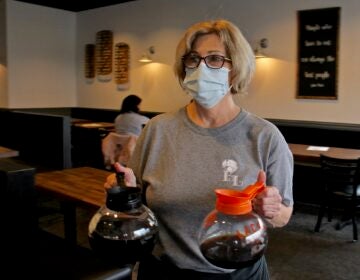
![CoronavirusPandemic_1024x512[1]](https://whyy.org/wp-content/uploads/2020/03/CoronavirusPandemic_1024x5121-300x150.jpg)
